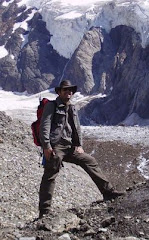The ongoing eruption of the Icelandic volcano Eyjafjallajokull caused much interest in the geoblogosphere (Italy, Portugal, U.S.A and Outside, geologists - but also paleontologists get interested, and of course magmaliceous volcanologists here and here) mainly because of the spectacular pictures available, but it's a reminder also for an interesting phenomenon, related with Quaternary geology. (so we got also Quaternologists).
Large volcanic eruptions throw huge amounts of ash and aerosols in the upper parts of the atmosphere, here atmospheric currents take the particles and distribute them widely, in some cases even around the planet. Sometimes this ash, or better it's effect, is seen in the sky, the dust particles and sulfur droplets deflect the sunlight during sun rising and setting, and turn the sky in vivid red colours. The fine particles will float in the atmosphere for months or even years, and finally sink to the bottom of the air ocean and deposit on the landscape.
Large volcanic eruptions throw huge amounts of ash and aerosols in the upper parts of the atmosphere, here atmospheric currents take the particles and distribute them widely, in some cases even around the planet. Sometimes this ash, or better it's effect, is seen in the sky, the dust particles and sulfur droplets deflect the sunlight during sun rising and setting, and turn the sky in vivid red colours. The fine particles will float in the atmosphere for months or even years, and finally sink to the bottom of the air ocean and deposit on the landscape.
 Fig.1. Tephra layer of the Laacher See volcanic eruption dated to 12.900+-560yr BP (with dendrological cross-references 12.916yr BP) in the limnic marls of the French lake Lautrey.
Fig.1. Tephra layer of the Laacher See volcanic eruption dated to 12.900+-560yr BP (with dendrological cross-references 12.916yr BP) in the limnic marls of the French lake Lautrey.So ash deposits, or Tephra, have very special features:
-they are erupted over very short time periods, geologically speaking, usually a matter of only hours or days to perhaps weeks or months
-they can be spread widely over land and sea to form a thin blanket that (unless reworked) has the same age wherever it occurs.
- The volcanic minerals can be dated by radiometric methods (Argon40-Argon39 for example)
- For some events we possess written reports, so if the layer is attributed to a determinate eruption, we can very precisely date the sediment. Historical accounts have provided accurate eruption years for many eruptions in countries where volcanic activity is common, in particular during the last 200-300 yr. In Europe historic events are recorded for 1783, when the ashes originated from the Icelandic Laki volcano reached the continent, Tambora in 1815 (recognized as volcanic event in Europe only with ongoing scientific research in 1855), Krakatau in 1883.
Therefore, once it is identified by its mineralogical and geochemical properties, a tephra layer provides a time-parallel marker bed or isochron for an 'instant' in time, and with this marker horizons a Tephrochronology of sediments can be established. Tephrostratigraphy' is another term that is commonly used and refers to the study of sequences of tephra layers and related deposits and their relative ages. Sigurdur Thorarinsson, an Icelandic volcanologist (who else?) is widely regarded as the modern 'father of this discipline, he realized in the twenties of the past century that the numerous Icelandic tephra layers offered great possibilities for correlation and dating.
After the first pioneering work, studies of tephra layers spread in the 1920s and 1930s in New Zealand, Japan, Iceland, South America and USA.
In Europe important sources for quaternary volcanic ashes are the larger volcanic districts, like Iceland, the Italian volcanoes (comprising active volcanoes as the Pleistocene volcanoes of Monticchio), the Auvergne in France, the Eifel in Germany with the important marker horizon of the Laacher See Tephra, the (ex-)Thera volcano in the Mediterranean Sea.
 Fig.2. Known distribution of major tephra localities and related volcanic districts. Iceland - Vedde Ash (VA), Germany - Laacher See (LST), and Italy - Neopolitan Yellow Tuff (NYT). The locations of the principal volcanic centers that were active during the period ca. 18.5 to 8 14C kyr BP are also identified (from ALLOWAY et al. 2007). It´s interesting to note that the fossil Vedde Ash distribution is similar to the recent ash-plumes over Europe (and here).
Fig.2. Known distribution of major tephra localities and related volcanic districts. Iceland - Vedde Ash (VA), Germany - Laacher See (LST), and Italy - Neopolitan Yellow Tuff (NYT). The locations of the principal volcanic centers that were active during the period ca. 18.5 to 8 14C kyr BP are also identified (from ALLOWAY et al. 2007). It´s interesting to note that the fossil Vedde Ash distribution is similar to the recent ash-plumes over Europe (and here). Fig.2. (a) Areal distribution and (b) isopach map of major Laacher See Tephra fans in Central Europe. Dashed line: outer detection limits of distal tephra layers. The signatures refer to different ash-units with different composition and deposition characteristics; LLST= Lower Laacher See Tephra, MLST= Mid Laacher See Tephra, ULST= Upper Laacher See Tephra (from SCHMINCKE et al. 1999).
Fig.2. (a) Areal distribution and (b) isopach map of major Laacher See Tephra fans in Central Europe. Dashed line: outer detection limits of distal tephra layers. The signatures refer to different ash-units with different composition and deposition characteristics; LLST= Lower Laacher See Tephra, MLST= Mid Laacher See Tephra, ULST= Upper Laacher See Tephra (from SCHMINCKE et al. 1999).REFERNCES:
ALLOWAY, B.V. et al. (2007): Tephrochronology. In (ed): ELIAS, S.A. (2006): Encyclopedia of quaternary science. Elsevier
SCHMINCKE, H.S.; PARK, C. & HARMS E., 1999: Evolution and environmental impacts of the eruption of Laacher See Volcano (Germany) 12,900 a BP; Quaternary International 61, 61-72





1 Kommentar:
where can I find soil samples results from volcanoes and craters throughout the world? I am testing a hypothesis
Kommentar veröffentlichen